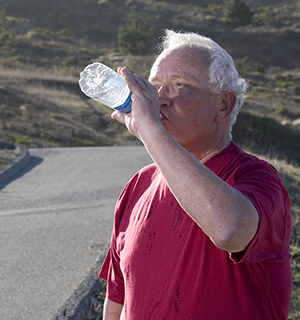Chronic Lung Disease: Tips for Safe Exercise
Chronic Lung Disease: Tips for Safe Exercise

Prepare for your workout
Here's how to get ready:
Plan your workout for the time of day when you normally have the most energy.
Dress for comfort. Wear shoes that support your feet.
Use a bronchodilator if one has been prescribed. For best results, use it 20 to 30 minutes before exercise or any other strenuous activity.
Clear your lungs of mucus if needed.
Use oxygen if it’s prescribed for use during activity. Increase the flow rate only if your healthcare provider has told you to. Increasing it on your own can be dangerous.
Check the weather before you start. On warm or humid days, reduce your workout, rest more often, and drink extra fluids. Exercise earlier in the day, before it gets hot. If it’s cold outside or if air quality is poor, exercise indoors. Walk inside your home or in a mall.
My starting goal is ________ minutes of exercise, ________ days a week.
Warm up and cool down
Here's what you can do before and after exercising:
To warm up, start with a few stretches. This gets your muscles ready for exercise.
After your stretches, move on to heavier activity. Pace yourself and remember to breathe.
Toward the end of your workout, decrease your effort so your body can cool down. Then stretch again. This relaxes your muscles and helps prevent soreness.
Rest and relax.
Stay safe during exercise
Tips for safe exercise:
Follow the guidelines your healthcare provider or pulmonary rehab team has set for you.
Pace yourself. Stop and rest when you need to.
Drink plenty of water before, during, and after exercise.
Remember that shortness of breath is OK, as long as you can talk and are in control of your breathing. Everyone gets short of breath during exercise—even people without chronic lung disease. But if you can’t speak, you’re pushing yourself too hard. If you have increased shortness of breath, slow down. If it continues, stop and rest.
Use pursed-lip breathing to control shortness of breath.
Keep your rescue inhaler with you. Use it if you need to.
Watch for signs of overexertion
Stop exercising right away and contact your healthcare provider if you feel any of these:
Unusual or increasing shortness of breath
Chest pain or discomfort
Burning, tightness, heaviness, or pressure in your chest
Unusual aching in your arms, shoulder, neck, jaw, or back
A racing or skipping heartbeat
Feeling much more tired than usual
Lightheadedness, dizziness, or nausea
Unusual joint pain
Updated:
November 17, 2017
Sources:
Qaseem, A. Diagnosis and Management of Stable Chronic Obstructive Pulmonary Disease: A Clinical Practice Guideline Update from the American College of Physicians, et al. Annals of Internal Medicine. 2011;155(3):s179-91., Reis, A. Pulmonary Rehabilitation: Joint American College of Chest Physicians/American Association of Cardiovascular and Pulmonary Rehabilitation Evidence-based Clinical Practice Guidelines. Chest. 2007;131(5):s4-42.
Reviewed By:
Berry, Judith, PhD, APRN,Blaivas, Allen J., DO,Image reviewed by StayWell art team.